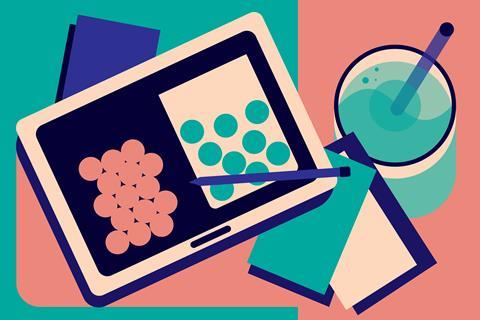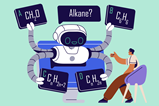How to harness edtech to enhance learners’ understanding and develop vital skills

At the start of September 2022 my school rolled out one-to-one devices to all students to aid teaching, learning and assessment. Each student has access to their own device that they can use in and out of class. It was a significant change, made easier by the fact that we’d already moved to mostly cloud-based working and the rapid adoption of online and hybrid teaching during school closures.
Digital learning encompasses the use of digital resources and technologies to enhance the learning and development of our students. It can change how we and they interact with each other, in groups and with resources. We also have wider responsibilities to prepare students for higher education and employment, where digital technologies will likely be key.
An element of play in learning helps to develop creative thinking and problem-solving skills
During my 15 years in teaching, I have always used technology in some form, with a desktop or laptop and projector/interactive whiteboard present in almost all lessons, allowing access to web-based resources including video, simulation and learning platforms. I often used these in delivery mode, directing students’ attention as a whole to the learning resources. If I wanted them to interact individually with a resource, I booked a computer room or set the work for homework.
Embedding digital resources
The big change came when all students had their own devices in class and were able to work individually or in small groups with the digital resources. A PhET resource is a clear example. I often use the states of matter simulation to exemplify solids, liquids and gases. It is informative and easy to control, while providing enough nuance and detail to be used effectively and repeatedly across all my teaching groups (11–18). When delivering, I’d show the simulation and use exposition and questioning to help students develop understanding. Now, I start in the same way but then give students time to explore the simulation, discuss with their peers and experiment with the variables. An element of play in learning helps to develop creative thinking and problem-solving skills – both critical to a scientific mindset. This overlaps well with Microsoft’s 21st-century learning design training and the skills that major employer surveys indicate are important in current and future work.
Time for change
The big change came when all students had their own devices in class and were able to work individually or in small groups with the digital resources. A PhET resource is a clear example. I often use the states of matter simulation (bit.ly/4bREmGw) to exemplify solids, liquids and gases. It is informative and easy to control, while providing enough nuance and detail to be used effectively and repeatedly across all my teaching groups (11–18). When delivering, I’d show the simulation and use exposition and questioning to help students develop understanding. Now, I start in the same way but then give students time to explore the simulation, discuss with their peers and experiment with the variables. An element of play in learning helps to develop creative thinking and problem-solving skills – both critical to a scientific mindset. This overlaps well with Microsoft’s 21st-century learning design training (bit.ly/4bXJdpx) and the skills that major employer surveys indicate are important in current and future work.
Using the SAMR model
I was convinced of the benefits of introducing student digital devices into classrooms and visited colleagues in other schools who were doing this. Based on these conversations, I recommended Ruben Puentedura’s substitution, augmentation, modification and redefinition (SAMR) model to help frame thinking at my school.
I was convinced of the benefits of introducing student digital devices into classrooms and visited colleagues in other schools who were doing this. Based on these conversations, I recommended Ruben Puentedura’s substitution, augmentation, modification and redefinition (SAMR) model to help frame thinking at my school: bit.ly/3yCzC9q.
When thinking about how to use digital technologies in teaching and learning, the model helps us consider how we will enhance current practice or transform what we do. For example, electronically distributing worksheets via OneNote (a common occurrence now) is substituting one method for another. There are benefits (no photocopying costs, no lost sheets, no time-intensive sticking in books) but, ultimately, the students are doing the same work. Augmentation could be taking that same OneNote page and embedding videos alongside the worksheet for students to watch if they get stuck, giving them the opportunity for more self-directed learning rather than waiting for the teacher. Transformation happens when we are modifying the learning experience with digital resources central to what the student is doing, or redefining, where we fundamentally change what the student is doing.
These changes happen more gradually as students and teachers gain confidence in the technology, and the curriculum is reviewed over time. For example, our geography department is exploring how Google Earth can be used to carry out virtual fieldwork in South America, allowing students to practise skills and complement their real-world fieldwork.
Evaluating the model
The SAMR model is useful in helping colleagues to think about and develop their current practice. One criticism is that it isn’t underpinned by research but developed through experience. As use of digital technologies develops at my school, we are looking at Fiona Aubrey-Smith’s and Peter Twining’s From EdTech to PedTech book to help evaluate and improve what we do.
The SAMR model is useful in helping colleagues to think about and develop their current practice. One criticism is that it isn’t underpinned by research but developed through experience. As use of digital technologies develops at my school, we are looking at Fiona Aubrey-Smith’s and Peter Twining’s From EdTech to PedTech book (bit.ly/4bzilN3) to help evaluate and improve what we do.
Sharing practice within and across departments, including what hasn’t worked, has been important in developing confidence and competence. In some departments OneNote Class Notebooks feature lots and are fully integrated into students’ learning and assessment. Others have taken a more hybrid approach, retaining traditional exercise books for practice drills and using web-based learning platforms for consolidation and exploration. This variety of educational experiences is important, challenging students to learn in different ways, and exposing them to the complexity of their world.
Take-home tips
- Contact local schools who have one-to-one student devices. The Microsoft Showcase Schools programme is useful for this.
- Form a small working group to explore how introducing devices could benefit your school.
- Identify pioneer departments to help train students early on in using one-to-one devices.
- Arrange regular training sessions, from whole school to drop-ins, to increase confidence and competence.
- Use the SAMR model to help frame your thinking about how to develop teaching, learning and assessment practice.
David Paterson is head of digital learning at Aldenham School














No comments yet